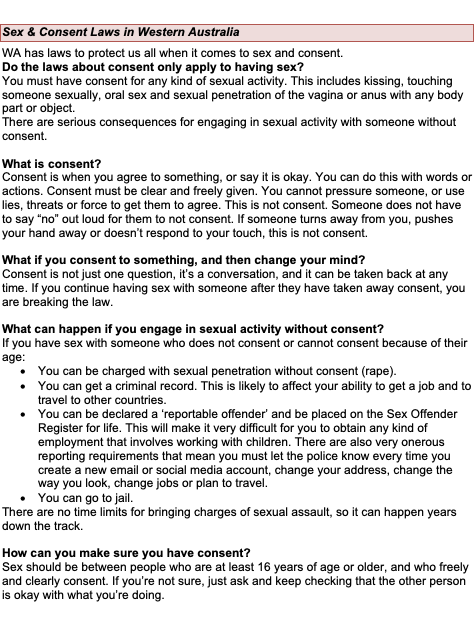Health
Factor | Description | Impact on Adolescent Health Behaviors |
Cultural Beliefs and Practices | Cultural beliefs encompass traditions, customs, religious beliefs, and values that are prevalent in a community or society. Practices relate to how these beliefs are acted upon. | Adolescents' health behaviors can be influenced by cultural expectations regarding diet, physical activity, substance use, and health care. For example, some cultures prioritize physical health through diet and exercise, while others might have more relaxed attitudes toward these areas. In some cases, cultural stigmas around mental health can affect adolescents' willingness to seek help. |
Family | Family includes parents, siblings, and other close relatives. Family structure, parenting styles, and family dynamics are part of this factor. | Family can impact adolescent health behaviors through role modelling, communication, support, and discipline. Positive family environments often lead to healthier choices, while high-conflict or dysfunctional families can lead to increased risk-taking behaviors. Parental expectations and involvement in adolescents' lives can shape their lifestyle choices, from diet to social activities.
|
Societal Norms | Societal norms are the unwritten rules and expectations that guide behavior within a community or society. | Societal norms dictate what is considered acceptable behavior, influencing adolescents' choices. For instance, societies that promote physical fitness may lead to increased physical activity among adolescents, while societies that normalise drug or alcohol use can increase risky behaviors. Societal pressures can also influence career choices, educational pursuits, and social relationships. |
Stereotypes and Expectations | Stereotypes are oversimplified ideas about groups of people, while expectations refer to assumptions about how people should behave based on these stereotypes. | Stereotypes and expectations can lead to pressures on adolescents to conform to specific roles or behaviors. Gender stereotypes might influence which sports or academic subjects’ adolescents pursue. Expectations about masculinity or femininity can affect emotional expression and mental wellbeing. Stereotypes about race, ethnicity, or socioeconomic status can limit opportunities and influence self-worth. |
The Media | The media encompasses television, movies, music, social media, and other forms of communication and entertainment. | Media can have both positive and negative influences on adolescent health behaviors. Positive portrayals of diversity and healthy lifestyles can encourage good habits. However, media can also promote unrealistic body images, risk taking behaviors like drug use or violence, and materialistic values. Social media can impact self-esteem, peer relationships, and increase exposure to harmful content. |
Body Image | Body image refers to an individual's perception of their physical appearance and how they feel about their body. | Body image can significantly affect adolescents' health behaviors, including diet, exercise, and mental wellbeing. A negative body image can lead to disordered eating, excessive exercise, or mental health issues like depression and anxiety. A positive body image can promote healthier lifestyle choices and increased self-confidence. Societal and media influences often shape body image perceptions. |
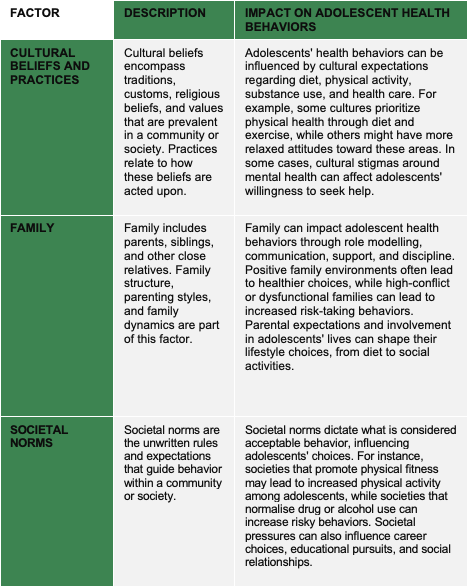
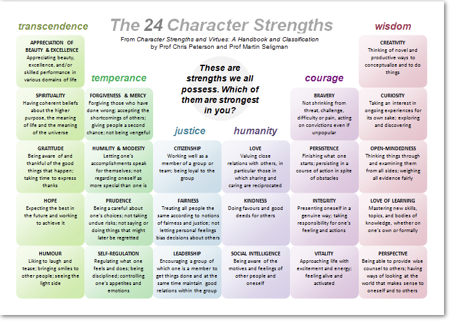
# | Way to Show Respect | Description | Examples/Tips |
1 | Practice Active Listening | Demonstrate that you value what others say by actively listening to them. Active listening shows that you are paying attention and value their ideas and opinion. | Ways to Practice: Use eye contact, ask questions, summarize what is being said. |
2 | Look for Common Ground | Find something that you share with others, such as a shared experience or value. This helps to build connections and respect among people. | Tip: When speaking with someone, ask open-ended questions to discover commonalities. |
3 | Seek to Understand Others | Use situations, especially those involving conflict, as opportunities to learn about others' perspectives. This approach can lead to deeper understanding and respect. | Tip: Instead of defending your opinion, ask about the basis of the other person's perspective. |
4 | Show Empathy for Differences | Even if you don't relate to someone's perspective, respect their right to have it. Recognize that everyone has a different background and experiences that shape their views. | Tip: Acknowledge the validity of others' perspectives, even if you don't agree. |
5 | Serve Others | Serving others is a way to give back and improve their lives. This can be through simple acts of kindness or larger gestures. | Example: Volunteer in your community or help a friend with a task they find difficult. |
6 | Apologize When You're Wrong | Admit mistakes and apologize. This shows empathy, care, and recognition of errors, helping to rebuild respect after a misstep. | Tip: If you make a mistake, don't try to cover it up. A simple "I'm sorry" can go a long way. |
7 | Be Polite | Being polite is about interacting positively with others. It requires minimal effort but can have a significant impact on how others perceive you. | Examples: Say "please" and "thank you," hold doors for others, use courteous language. |
8 | Show Gratitude | Showing gratitude is deeper than simple politeness; it's about expressing sincere appreciation for others. This demonstrates that you value their contributions and efforts. | Example: Write thank-you notes or express appreciation verbally with genuine warmth. |
Empathy and Sympathy
Empathy Definition:
Empathy means experiencing someone else’s feelings.’ It requires an emotional component of really feeling what the other person is feeling and having a related emotion.
Sympathy Definition:
Sympathy, means understanding someone else’s suffering without connection to it. It’s more cognitive in nature and keeps a certain distance. It recognises an emotion without sharing that emotion.
Watch: https://youtu.be/KZBTYViDPlQ
How can you practice empathy
1. Watch and listen. Listening is one of the most effective ways you can demonstrate empathy to other people. When you are practicing active listening, you are listening with purpose, you aren’t fiddling on your phone or thinking about what you’re going to do after school, you’re really taking in what the other person is saying. Make eye contact, don’t interrupt and ask questions to show that you’re making a genuine effort to understand what they’re going through.
2. Remember. When did you feel the same way?
3. Imagine. How does the other person feel and how would you feel in the same situation?
4. Ask. Ask what the person is feeling. Ask more ‘you’ questions compared to the number of ‘I’ statements you make.
5. Withhold judgements. This is an important step when practicing empathy. It can be really hard to withhold judgement. Try to gain a deeper understanding of someone else’s perspective without immediately saying that is good or bad. This doesn’t mean that the other person is right or good, and of course this is not to say if someone is acting badly or behaving like a bully, or saying things that are racist, sexist or homophobic that you shouldn’t intervene or say something. \
6. Show you care and offer help. Let the person know through your words and actions that you care, and you’re willing to take time out of your day to do something to make life easier for them.
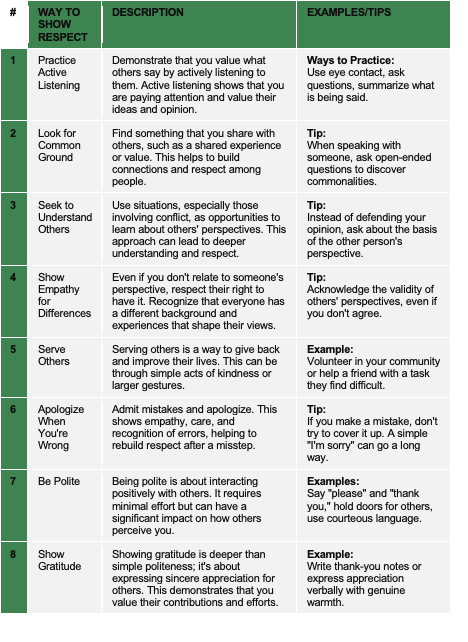
# | Refusal Skill | Why It Works | Tips/Examples |
1 | Just say no. | A confident, simple “no” says that the conversation is over. | Tip: Make eye contact and use a clear voice to sound confident even if you're uncomfortable. |
2 | Suggest an alternative activity. | Offering an alternative tells the person you still want to spend time with them, but in a way that you're comfortable with. | Example: “No thanks. Actually, let's get some food. I'm starving.” |
3 | Leave the situation. | Once you're out of the situation, the pressure decreases. This gives you time to figure out your next steps. | Examples: Leave the conversation, leave the room, or leave the location. Tip: Create a safety codeword to send to a parent or trusted adult, so they can come to pick you up. |
4 | Reverse the pressure. | Reversing the pressure gives you more control over the situation. | Examples: "If you love me, you'll do this." Response: "If you love me, you won't pressure me to." "Just try it once. If you hate it, I won't ask again." Response: "No. Why would I do something I'm going to hate?" |
5 | Use humor. | A joke or a lighthearted comment can lift the tension. | Examples: "If I smoke, I'll smell as bad as you." "I'm fun already. I don't need that." |
6 | Ignore the offer. | No response sends a message that you're not interested. | Examples: Don't reply to a text or acknowledge the offer. Continue talking or hanging out as if it never happened. |
7 | Give an excuse. | Excuses give the person an explanation for why you're saying no. | Examples: "No thanks. I always get a headache when I'm around cigarette smoke." "You know I'm a terrible liar. If my parents ask, we will get caught." |
8 | Pass the blame. | When you pass the blame, you don't have to defend yourself or your choice. | Example: "Are you trying to get rid of me? My parents would never let us hang out again." |
9 | Pull in help. | Bringing in other people reverses the peer pressure. | Example: "Hey guys, help me out. I told him 'no,' but he won't leave me alone." |
10 | Change the subject. | Changing the topic sends a message that your mind is made up. | Example: "No thanks. Hey, how did you like that movie?" |
Coping Strategies
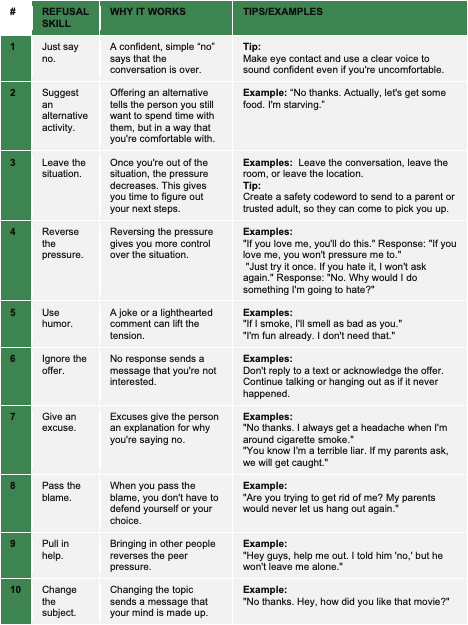
Coping skills are methods a person uses to deal with stressful situations. Obtaining and maintaining good coping skills takes practice. However, utilizing these skills becomes easier over time. Most importantly, good coping skills make for good mental wellbeing.
Positive coping skills:
Category | Example |
Accept responsibility | Admit your own role in the problem and try to put things right: • Say that you know that your parents are only concerned about your safety and that you shouldn’t have yelled at them for not letting you go to the party and do the dishes for the next week. |
Positive appraisal | You reflect on the problem and try to create a positive meaning by focusing on personal growth: • Say things like – This is something I can learn from and become a better person. |
Self-control | You apply effort to control your feelings and actions: • Not telling your parents what you think of them when they won’t let you go to the party |
Distraction / Distancing
| Keep yourself busy to take your mind off the issue. Think about other things rather than your problem to try and make it seem less important: Say things like – It’s doesn’t matter. The party was probably stupid anyway. I’m too angry now. I’ll think about it again when I’ve calmed down. |
Praying for guidance and strength / Meditation | Acknowledging problems Mindfulness |
Emotional disclosure / Seek social support | Involves expressing strong emotions by talking or writing about the negative events You make an effort and seek informational support, material support and emotional support: • Talk to someone you trust and tell them how you are feeling. • Call a helpline and talk to a counsellor. • Say – I’ve done something stupid and feel really bad. I need your help |
Problem solving | Work how best to change the situation by focusing on the problem rather than your feelings. |
Time Management | The process of organising and planning how to divide your time between different activities. Work smarter, not harder. |
Negative coping skills:
Category | Example |
Self Harm | Over-eating Self-Mutilation Excessive exercising
|
Drugs &/or Alcohol | Excessive alcohol use Use of stimulants or sedatives |
Distancing | Avoiding problems/Denial Think about other things to make the event seem less important Excessive working
|
Confrontational | Acting aggressively to try to alter the situation. This is letting feelings control the situation and could negatively affect the relationship between myself and others. |
Escape or avoid | Pretend your problem doesn’t exist. Ignoring or storing hurt feelings |
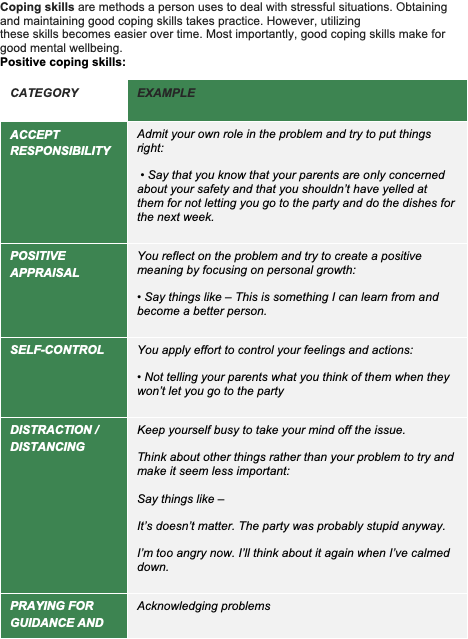
Sex & Consent Laws in Western Australia
WA has laws to protect us all when it comes to sex and consent.
Do the laws about consent only apply to having sex?
You must have consent for any kind of sexual activity. This includes kissing, touching someone sexually, oral sex and sexual penetration of the vagina or anus with any body part or object.
There are serious consequences for engaging in sexual activity with someone without consent.
What is consent?
Consent is when you agree to something, or say it is okay. You can do this with words or actions. Consent must be clear and freely given. You cannot pressure someone, or use lies, threats or force to get them to agree. This is not consent. Someone does not have to say “no” out loud for them to not consent. If someone turns away from you, pushes your hand away or doesn’t respond to your touch, this is not consent.
What if you consent to something, and then change your mind?
Consent is not just one question, it’s a conversation, and it can be taken back at any time. If you continue having sex with someone after they have taken away consent, you are breaking the law.
What can happen if you engage in sexual activity without consent?
If you have sex with someone who does not consent or cannot consent because of their age:
· You can be charged with sexual penetration without consent (rape).
· You can get a criminal record. This is likely to affect your ability to get a job and to travel to other countries.
· You can be declared a ‘reportable offender’ and be placed on the Sex Offender Register for life. This will make it very difficult for you to obtain any kind of employment that involves working with children. There are also very onerous reporting requirements that mean you must let the police know every time you create a new email or social media account, change your address, change the way you look, change jobs or plan to travel.
· You can go to jail.
There are no time limits for bringing charges of sexual assault, so it can happen years down the track.
How can you make sure you have consent?
Sex should be between people who are at least 16 years of age or older, and who freely and clearly consent. If you’re not sure, just ask and keep checking that the other person is okay with what you’re doing.
